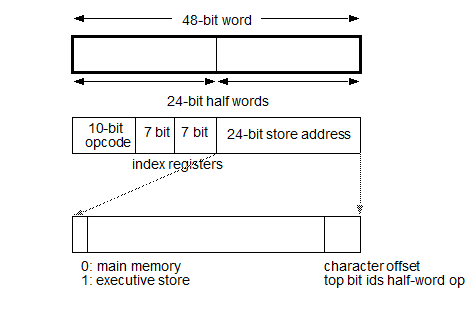One-Level Storage System
Kilburn, Edwards, Lanigan, Sumner (1961)
Superset of: Dynamic Storage Allocation in the Atlas Computer, Including an Automatic Use of Backing Store, Fotheringham (1961).
What kind of paper?
-
New idea.
-
Motivation.
-
Explanation.
-
Algorithms.
Atlas Architecture
-
Three areas of storage:
-
Private store: For the OS
-
Central store: core and drum
-
Tape store: large persistent memorry
-
ISA
-
Single operand
-
SW-provided (stored in actual CORE memory -- read-only -- think system calls):
-
shift
-
trig functions
-
Device drivers
-
i/O conversion
-
accounting
-
OS
-
Configuration
-
half MIP machine
-
50 bit words .4
μ
sec access time within column
-
Change of column adds 1
μ
sec.
-
Working space 1.8
μ
sec.
-
Capacity is 10
6
, 96,000 words on 4 drums
-
Up to 8 tape decks, each produces a word every 88
μ
sec
-
V-store (registers -- variable store?)
-
b->S
-
s->B
-
-
B-store
-
Fast core storer (.7
μ
sec access)
-
120 24-bit words
-
main control: execute regular instructions
-
extracode: execute "system calls"
-
interrupt control: handles interrups
-
24-bit address:
-
block address (9 bits) and line address (9 bits)
-
block is 512 words
-
0/1 in low bit says that you can access characters in a halfword
-
the second bit indicates which half word
-
0: most significant half word
-
1: least significant half word
-
00: most significant character
-
11: least significant character
-
87-bit FP accumulator.
-
128 24-bit index registers (90 available for general use).
-
Executive store includes ROM for Supervisor.
Memory Arrangement
-
512-byte blocks/pages.
-
One Page Address Register per in-memory (core) page.
-
PAR contains the address of the page currently resident in memory.
-
Priority scheme of handling tape and drum.
-
Memory is banked into 4 stacks.
Motivation for single-level store
-
Too expensive to make entire memory core store.
-
Too slow to make entire memory drum.
-
Desire: performance of core at cost of drum.
Implementation of single-level store
-
Fully associative lookup on every address .
-
If address found in a PAR, then the data is returned.
-
If no PAR match, generate interrupt.
-
Note placing of address in V-store stores the faulting address.
-
Control is transferred to the equivalent of the page-fault handler.
-
Keep track of drum position in terms of block.
-
Use a WAFL algorithm to assign blocks to drum. .
-
Block address goes in PAR until drum is correctly positioned to prevent transfer to wrong block.
Learning program
-
First use of "use" bits.
-
One use bit per page.
-
Can perform transfers (memory to drum; drum to memory) in either order if you leave room on both media.
-
Lock-out bit prevents programs from accessing blocks that are being transferred.
-
Page replacement: use past to predict future.
-
Periodically read all use bits and store them; reset use bits to 0.
-
Calculate t and T, lengths of the last two intervals of inactivity.
-
Apply following algorithm:
-
If t is > T + 1, use it .
-
Pick page with the maximum T-t such that t != 0 .
-
Pick maximum T .
-
For all blocks on drum, calculate tau which is the time of last use.
-
When moving page from drum to memory, set T to be idle time since last use (current time -tau); t gets set to 0.
Arguments why Atlas provides flexibility
-
Can spread things out in the address space to allow for growth.
-
Programs can move between machines with different memory sizes easily.
-
Only storage allocation a programmer needs to think about is allocating data to pages.
